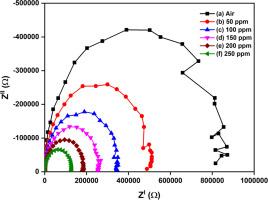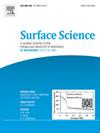雾化器喷雾热解(NSP)技术制备二氧化锰纳米晶薄膜的温度依赖光学透过率和气敏机理
IF 1.8
4区 化学
Q3 CHEMISTRY, PHYSICAL
引用次数: 0
摘要
在这项工作中,利用雾化器喷雾热解技术在300 ~ 600℃的衬底温度下成功地合成了纳米晶MnSnO₃薄膜。x射线衍射(XRD)分析证实了多晶菱面体结构,晶粒尺寸从300℃时的25 nm增加到600℃时的42 nm。扫描电镜(SEM)显示,由于热激活晶粒生长,低温下的球形晶粒在600℃时转变为较大的片状晶粒(~ 110 nm)。能量色散x射线光谱(EDAX)证实了元素组成,HRTEM-SAED分析证实了高晶体质量。光学研究表明,透射率随温度升高而增加,带隙从2.03 eV扩大到2.50 eV。气敏实验表明,在氨浓度为250 ppm时,膜的最大灵敏度为6.7,阻抗谱表明在气体暴露时电行为发生了显著变化。这些结果突出了MnSnO₃薄膜用于高性能、经济高效的氨气传感器的潜力。本文章由计算机程序翻译,如有差异,请以英文原文为准。

Temperature-dependent optical transmittance and gas sensing mechanism of MnSnO3 nanocrystalline thin-films through the nebulizer spray pyrolysis (NSP) technique
In this work, nanocrystalline MnSnO₃ thin films were successfully synthesized using the nebulizer spray pyrolysis technique at substrate temperatures ranging from 300 °C to 600 °C. X-ray diffraction (XRD) analysis confirmed the polycrystalline rhombohedral structure, with crystallite size increasing from 25 nm at 300 °C to 42 nm at 600 °C. Scanning electron microscopy (SEM) revealed spherical grains at lower temperatures transitioning to larger, plate-like grains (∼110 nm) at 600 °C due to thermally activated grain growth. Energy-dispersive X-ray spectroscopy (EDAX) confirmed the elemental composition, and HRTEM-SAED analysis validated high crystalline quality. Optical studies showed that transmittance increased with temperature, and the optical band gap widened from 2.03 eV to 2.50 eV. Gas sensing experiments demonstrated that the films exhibited a maximum sensitivity of 6.7 at 250 ppm ammonia concentration, with impedance spectra indicating significant changes in electrical behavior upon gas exposure. These results highlight the potential of MnSnO₃ thin films for use in high-performance, cost-effective ammonia gas sensors.
求助全文
通过发布文献求助,成功后即可免费获取论文全文。
去求助
来源期刊

Surface Science
化学-物理:凝聚态物理
CiteScore
3.30
自引率
5.30%
发文量
137
审稿时长
25 days
期刊介绍:
Surface Science is devoted to elucidating the fundamental aspects of chemistry and physics occurring at a wide range of surfaces and interfaces and to disseminating this knowledge fast. The journal welcomes a broad spectrum of topics, including but not limited to:
• model systems (e.g. in Ultra High Vacuum) under well-controlled reactive conditions
• nanoscale science and engineering, including manipulation of matter at the atomic/molecular scale and assembly phenomena
• reactivity of surfaces as related to various applied areas including heterogeneous catalysis, chemistry at electrified interfaces, and semiconductors functionalization
• phenomena at interfaces relevant to energy storage and conversion, and fuels production and utilization
• surface reactivity for environmental protection and pollution remediation
• interactions at surfaces of soft matter, including polymers and biomaterials.
Both experimental and theoretical work, including modeling, is within the scope of the journal. Work published in Surface Science reaches a wide readership, from chemistry and physics to biology and materials science and engineering, providing an excellent forum for cross-fertilization of ideas and broad dissemination of scientific discoveries.
 求助内容:
求助内容: 应助结果提醒方式:
应助结果提醒方式:


